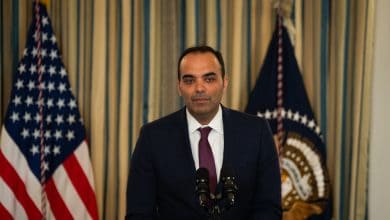Fed Officials Thought Rates Could Rise More if Inflation Stayed Stubborn

Federal Reserve officials are contemplating whether they will need to raise interest rates again to cool the economy and ensure that rapid inflation will fully fade, and minutes from their meeting earlier this month laid out the contours of that debate.
“Participants noted that further tightening of monetary policy would be appropriate if incoming information indicated that progress toward the committee’s inflation objective was insufficient,” according to minutes from the central bank’s Oct. 31-Nov. 1 meeting, which were released Tuesday.
Fed officials thought that the “data arriving in coming months would help clarify the extent to which the disinflation process was continuing.”
Central bankers voted to leave interest rates unchanged in a range of 5.25 to 5.5 percent at their gathering early this month, allowing themselves more time assess whether their substantial rate moves so far are weighing on demand.
Wall Street is keenly focused on what officials will do next. Fed policymakers had predicted one more 2023 rate move as of their September economic projections, but investors think that there is little chance they will raise rates at their final meeting of the year on Dec. 12-13. Tuesday’s minutes may serve to bolster that expectation of an extended pause, because they suggested that officials planned to watch how the economy shaped up over the course of “months.”
Fed watchers are now trying to figure out whether officials are conclusively done raising interest rates and, if so, when they are likely to begin cutting them. Policymakers will publish a fresh set of quarterly economic forecasts at the conclusion of their December meeting. Those, together with remarks from Fed Chair Jerome H. Powell, could provide important clues about the future.
As of September, policymakers expected to lower rates before the end of 2024. If that forecast stands and Mr. Powell hints that policymakers are not eager to raise rates again, investors may turn their full attention to just how soon rate cuts are coming. As of now, market pricing suggests that Wall Street expects policymakers to begin lowering interest rates at some point in the first half of 2024.
But if Fed officials use the December economic projections to predict that rates could remain higher for longer — or if Mr. Powell suggests that a rate increase next year remains firmly on the table — it could keep the possibility of more action at least dimly alive. Several central bankers have been clear in recent weeks that they aren’t sure they are done raising interest rates.
“I wouldn’t take additional firming off the table,” Susan Collins, the president of the Federal Reserve Bank of Boston, said in an interview on CNBC last week.
The minutes from the Fed’s November gathering fleshed out how policymakers are thinking about the outlook. While officials wanted to make sure that they were cooling the economy enough to ensure that inflation would come back to their 2 percent goal in a timely way, they also wanted to avoid overdoing it by raising rates too much and risking a painful recession.
Fed officials thought that “with the stance of monetary policy in restrictive territory, risks to the achievement of the committee’s goals had become more two-sided,” the minutes said, though “most participants continued to see upside risks to inflation.”
Consumer Price Index inflation fell to 3.2 percent in October, down from a peak above 9 percent in summer 2022. Even so, officials are worried that it could prove difficult to wrestle inflation the rest of the way back to normal.
Fed officials define their inflation target using a separate but related measure, the Personal Consumption Expenditures index, which comes out at more of a delay. The October P.C.E. figures are set for release on Nov. 30.
Fed officials have been carefully watching strength in the job market and the economy as they try to figure out whether inflation is likely to come fully under control. If the economy retains too much vim — with consumers spending freely and businesses snapping up workers — companies may continue to raise prices at a faster clip than usual.
Since their last meeting, the Fed has gotten some positive news on that front. While employers continued to hire in October, they did so at a much slower pace: They hired just 150,000 workers, and earlier hiring figured were revised lower.
The minutes suggested that policymakers are watching for signs that “labor markets were reaching a better balance between demand and supply.”




